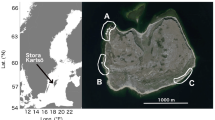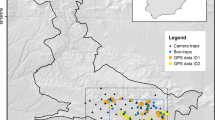Abstract
The models presented in this paper are motivated by a stop-over study of semipalmated sandpipers, Calidris pusilla. Two sets of data were collected at the stop-over site: a capture–recapture–resighting data set and a vector of counts of unmarked birds. The two data sets are analyzed simultaneously by combining a new model for the capture–recapture–resighting data set with a binomial likelihood for the counts. The aim of the analysis is to estimate the total number of birds that used the site and the average duration of stop-over. The combined analysis is shown to be highly efficient, even when just 1 % of birds are recaptured, and is recommended for similar investigations. This article has supplementary material online.
Similar content being viewed by others
References
Alerstam, T., and Lindström, A. (1990), “Optimal Migration: The Relative Importance of Time, Energy, and Safety,” in Bird Migration: Physiology and Ecophysiology, ed. E. Gwinner, Berlin: Springer, pp. 331–351.
Bart, J., Andres, B., Brown, S., Donaldson, G., Harrington, B., Johnston, V., Jones, S., Morrison, R. I. G., and Skagen, S. K. (2005), “The Program for Regional and International Shorebird Monitoring (PRISM),” in Bird Conservation Implementation and Integration in the Americas: Proceedings of the Third International Partners in Flight Conference, Volume 2, March 20–24, 2002, Asilomar, California. General Technical Report PSW-GTR-191. Albany, CA: U.S. Forest Service, Pacific Southwest Research Station, eds. C.J. Ralph and T.D. Rich.
Besbeas, P., Freeman, S. N., Morgan, B. J. T., and Catchpole, E. A. (2002), “Integrating Mark-Recapture-Recovery and Census Data to Estimate Animal Abundance and Demographic Parameters,” Biometrics, 58, 540–547.
Bowden, D. C., and Kufeld, R. C. (1995), “Generalized Mark-Sight Population Size Estimation Applied to Colorado Moose,” The Journal of Wildlife Management, 59, 840–851.
Brown, S., Hickey, C., Harrington, B., and Gill, R. (2001), The U.S. Shorebird Conservation Plan (2nd ed.), Manomet: Manomet Center for Conservation Sciences.
Collazo, J. A., Oharra, D. A., and Kelly, C. A. (2002), “Accessible Habitat for Shorebirds: Factors Influencing Its Availability and Conservation Implications,” Waterbirds, 25, 13–24.
Frederiksen, M., Fox, A. D., Madsen, J., and Colhoun, K. (2001), “Estimating the Total Number of Birds Using a Staging Site,” The Journal of Wildlife Management, 65, 282–289.
Loesch, C. R., Twedt, D. J., Tripp, K., Hunter, W. C., and Woodrey, M. S. (2000), “Development of Management Objectives for Waterfowl and Shorebirds in the Mississippi Alluvial Valley,” in Strategies for Bird Conservation: The Partners in Flight Planning Process: Proceedings of the 3rd Partners in Flight Workshop, U.S. Department of Agriculture, Forest Service, Proceedings RMRS-P-16, eds. R. Bonney, D. N. Pashley, R. Cooper and L. Niles, pp. 8–11.
Lyons, J. E., and Collazo, J. A. (2001), “Verifying Assumptions Underlying Shorebird Conservation in the Southeastern USA and the Caribbean.” Final Report to “Species at Risk Program”, “US Geological Survey” and “US Fish and Wildlife Service”.
Lyons, J. E., Runge, M. C., Laskowski, H. P., and Kendall, W. L. (2008), “Monitoring in the Context of Structured Decision-Making and Adaptive Management,” The Journal of Wildlife Management, 72, 1683–1692.
McClintock, B. T., and Hoeting, J. A. (2010), “Bayesian Analysis of Abundance for Binomial Sighting Data With Unknown Number of Marked Individuals,” Environmental and Ecological Statistics, 17, 317–332.
McClintock, B. T., and White, G. (2012), “From NOREMARK to MARK: Software for Estimating Demographic Parameters Using Mark-Resight Methodology,” Journal of Ornithology, 152 (2), S641–S650.
McClintock, B. T., White, G. C., and Burnham, K. P. (2006), “A Robust Design Mark-Resight Abundance Estimator Allowing Heterogeneity in Resighting Probabilities,” Journal of Agricultural, Biological, and Environmental Statistics, 11, 231–248.
McGowan, C. P., Hines, J. E., Nichols, J. D., Lyons, J. E., Smith, D. R., Kalasz, K. S., Niles, L. J., Dey, A. D., Clark, N. A., Atkinson, P. W., Minton, C. D. T., and Kendall, W. (2011), “Demographic Consequences of Migratory Stopover: Linking Red Knot Survival to Horseshoe Crab Spawning Abundance,” Ecosphere, 2 (6), 69.
Minta, S., and Mangel, M. (1989), “A Simple Population Estimate Based on Simulation for Capture-Recapture and Capture-Resight Data,” Ecology, 70, 1738–1751.
Myers, J. P., Morrison, R. G., Antas, P. Z., Harrington, B. A., Lovejoy, T. E., Sallaberry, M., Senner, S. E., and Tarak, A. (1987), “Conservation Strategy for Migratory Species,” American Scientist, 75, 18–26.
Nasution, M. D., Brownie, C., Pollock, K. H., and Bennetts, R. E. (2001), “Estimating Survival From Joint Analysis of Resighting and Radiotelemetry Capture-Recapture Data for Wild Animals,” Journal of Agricultural, Biological, and Environmental Statistics, 6, 461–478.
Nichols, J. D., and Williams, B. K. (2006), “Monitoring for Conservation,” Trends in Ecology & Evolution, 21, 668–673.
Pledger, S., Efford, M., Pollock, K. H., Collazo, J. A., and Lyons, J. E. (2009), “Stopover Duration Analysis With Departure Probability Dependent on Unknown Time Since Arrival,” Environmental and Ecological Statistics, 3, 349–363 (Edited by D.L. Thomson, E.G. Cooch and M.J. Conroy).
Pollock, K. H. (1982), “A Capture-Recapture Design Robust to Unequal Probability of Capture,” The Journal of Wildlife Management, 46, 752–757.
Pollock, K. H., Nichols, J. D., Brownie, C., and Hines, J. E. (1990), “Statistical Inference for Capture-Recapture Experiments,” Wildlife Monographs, 107, 3–97.
Rice, S. M., Collazo, J. A., Alldredge, M. W., Harrington, B. A., and Lewis, A. R. (2007), “Local Annual Survival and Seasonal Residency Rates of Semipalmated Sandpipers (Calidris Pusilla) in Puerto Rico,” The Auk, 124, 1397–1406.
Schaub, M., Pradel, R., Jenni, L., and Lebreton, J.-D. (2001), “Migrating Birds Stop Over Longer Than Usually Thought: An Improved Capture-Recapture Analysis,” Ecology, 82, 852–859.
Schwarz, C. J., and Arnason, A. N. (1996), “A General Methodology for the Analysis of Capture-Recapture Experiments in Open Populations,” Biometrics, 52, 860–873.
Skagen, S. K., Granfors, D. A., and Melcher, C. P. (2008), “On Determining the Significance of Ephemeral Continental Wetlands to North American Migratory Shorebirds,” The Auk, 125, 20–29.
Weber, L. M., and Haig, S. M. (1996), “Shorebird Use of South Carolina Managed and Natural Coastal Wetlands,” The Journal of Wildlife Management, 60, 73–82.
White, G., and Shenk, T. (2001), “Population Estimation With Radio-Marked Animals,” in Radio Tracking and Animal Populations, eds. J. Millspaugh and J. M. Marzluff, pp. 329–350.
Author information
Authors and Affiliations
Corresponding author
Electronic Supplementary Material
Below is the link to the electronic supplementary material.
Rights and permissions
About this article
Cite this article
Matechou, E., Morgan, B.J.T., Pledger, S. et al. Integrated Analysis of Capture–Recapture–Resighting Data and Counts of Unmarked Birds at Stop-Over Sites. JABES 18, 120–135 (2013). https://doi.org/10.1007/s13253-013-0127-0
Received:
Accepted:
Published:
Issue Date:
DOI: https://doi.org/10.1007/s13253-013-0127-0




